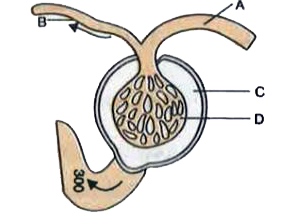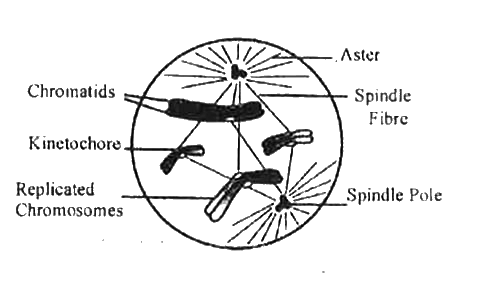InterviewSolution
This section includes InterviewSolutions, each offering curated multiple-choice questions to sharpen your knowledge and support exam preparation. Choose a topic below to get started.
| 15951. |
Question :Label the given diagram. |
|
Answer» SOLUTION :A.Common hepatic duct (B) Common bile duct ("C") Pancreatic duct (duct of WIRSUNG) (D)SPHINCTER of Oddi E. Cystic duct. |
|
| 15952. |
Question : Label the followingparts in the given diagram usingarrow. (a) Aqueous chamber . (b) Cornea. (c) Lens (d) Retina. (e) Vitreouschamber.(f)Blind spot |
Answer» SOLUTION :Reprsentationof the FOLLOWINGPARTS of EYE. 
|
|
| 15953. |
Question : Label the following parts in the following diagram: {:("A. Afferent arteriole","B. Efferent arteriole"),("C. Bowman's capsule","D. Glomerulus."):} |
Answer» SOLUTION :
|
|
| 15954. |
Question : Label the following diagram |
| Answer» SOLUTION :(i) Cell WALL (ii) Pyrenoid (iii) Eye spot (iv) Nucleus (v) Chloroplast (vi) SPOROPHYTE (vii) RHIZOIDS (viii) Frond (ix) Sorus (x) SPORANGIUM | |
| 15955. |
Question : Label the diagram and also determine the stage at which this stucture is visible. |
Answer» SOLUTION :
|
|
| 15956. |
Question : Label the diagram and also determine the stage at which this structure visible. |
Answer» Solution :The diagram shows the transition STAGE between PROPHASE and metaphase stage MITOTIC CELL division. 
|
|
| 15957. |
Question : Label the different components of actin filaments in the diagram given below. |
Answer» SOLUTION :
|
|
| 15958. |
Question : Label the diagram (A) This is which part of a dicotyledonous plant ? (B) If we remove part 1 from the plant, what will happen ? |
|
Answer» Solution :(a) Shoot apical meristem (B) Removal of shoot apical meristem CAUSES inhibition of apical bud and GROWTH of axillary but `1 rarr `shoot apical meristem, 2 - axillary bud `3rarr` LEAF primordium. 
|
|
| 15959. |
Question : Kreb's cycle is ………….in nature. |
|
Answer» ANABOLIC |
|
| 15960. |
Question : Krebs. cycle is an importantprocess. |
| Answer» Solution :For complete OXIDATION of Glucose in aerobicrespiration, Krebs. cycle OXIDATIVE phosphorylation takes place. ATP is FORMED by oxidation of `NADH_(2) and FADH_(2)`produced in Krebs. cycle . In addition, itprovides pathwayfor complete oxidation of glucose. It provides pathwayof ATP synthesis. Moreover various organiccomplexes nucleotideplay an importantrolein creation of dilute cytochrome. | |
| 15961. |
Question : Krebs cycle is an amphibolic pathway - Comment. |
| Answer» Solution :Krebs cycle is PRIMARILY a catabolic PATHWAY, but it provides precursors for various biosynthetic pathway there by an anabolic pathway too. Hence, it is CALLED amphibolic pathway. It serves as a pathway for OXIDATION of carbohydrates, fats and proteins. | |
| 15962. |
Question : Kranzz Anatony - Define. |
| Answer» SOLUTION :Karnz ANATOMY is the German term meaninga halo or wreath . In `C_(4)`plantsvascularbundles aresurrounded by a LAYEROF bundlesheath. Bundlesheatheris surrounded by a ring of mesophyllcells. | |
| 15963. |
Question : Kranz sheath in granes perform . . . . . . . . . . photosynthesis. |
| Answer» ANSWER :B | |
| 15964. |
Question : Kranz anatomy occurs in |
|
Answer» LEAVES |
|
| 15965. |
Question : Kranz anatomy is present in |
|
Answer» Maize |
|
| 15966. |
Question : Kranz anatomy is one of the characteristics of the leaves of ______ |
|
Answer» `C_1 PLANTS``C_2 plants` |
|
| 15967. |
Question : Kranz anatomy is observed in: |
|
Answer» `C_2` PLANTS |
|
| 15968. |
Question : Kranz anatomy is found in the leaves of |
| Answer» Answer :B | |
| 15969. |
Question : Kojic acid is produced by ……………………………………………… |
|
Answer» ASPERGILLUS terreus |
|
| 15970. |
Question : Knee joint is an example of .... |
| Answer» Solution :hinge joint | |
| 15971. |
Question : Knee joint and elbow joints are example of |
| Answer» Answer :D | |
| 15972. |
Question : Knee joint and elbow joints are examles of |
| Answer» Answer :D | |
| 15973. |
Question : Kingdom : What is Kingdom ? |
|
Answer» SOLUTION :All animals belonging to various phyla are assigned to the HIGHEST category CALLED Kingdom ANIMALIA in the classification system of animals. The Kingdom Plantae, is DISTINCT and comprises all plants from various division. These two groups are refered as animal and plant kingdoms. |
|
| 15974. |
Question : Kingdom protista does not include |
|
Answer» PHOTOSYNTHETIC algae |
|
| 15975. |
Question : Kingdom monera members do not contain |
|
Answer» CELL wall |
|
| 15976. |
Question : Kingdom fungi includes organisms that are |
|
Answer» ACHLOROPHYLLOUS |
|
| 15977. |
Question : Kinetochore: |
|
Answer» Solution :Location : Every CHROMOSOME ESSENTIALLY has a primary constriction on the centromere on the sides of which disc SHAPED STRUCTURES called kinetochores. Function : It acts as a connection surface for SPINDLE fibres. |
|
| 15978. |
Question : Kin selection is seen in ________. |
| Answer» Answer :A | |
| 15979. |
Question : Kidneysmolluscsare also referred to as |
|
Answer» Keber's organs |
|
| 15980. |
Question : Kidney stones are produced due to deposition of uric acid and |
|
Answer» SILICATES |
|
| 15981. |
Question : Kidney of frog is |
|
Answer» Archinephros |
|
| 15982. |
Question : Kidney of adult reptiles are ……………………….. . |
|
Answer» mesonephric |
|
| 15983. |
Question : Khornaand hiscolleaguarsythesizedand RNAmole-culewithrepeatingsequencesof U" "GN_(2)-basethe RNAwith "UGU" "GUG""UGU" "GUG" produced a tertra peptidewithalternatingsequence ofcysteinandvaline, thisprovethatcodonfor cysteinandvaline is |
|
Answer» UGG & GUU |
|
| 15984. |
Question : Kidney functioning is regulated by hormonal feedback control mechanism. Explain this mechanism. |
|
Answer» Solution :1. The functioning of KIDNEYS is efficiently monitored and regulated by hormonal feedback control mechanism involving the hypothalamus, juxta glomerular apparatus and to a certain extent the heart. 2. Osmoreceptors in the hypothalamus are activated by changes in the blood volume, body fluid volume and ionic concentration. 3. When there is excessive loss of fluid from the body or when there is an increase in the blood pressure, the osmoreceptors of the hypothalamus respond by STIMULATING the neurohypophysis to secrete the antidiuretic HORMONE (ADH) or vasopressin (a positive feedback). 4.ADH facilitates reabsorption of water by increasing the number of aquaporins on the cell surface membrane of the distal convoluted tubule and collecting duct. 5.This increase in aquaporins causes the movement of water from the lumen into the INTERSTITIAL cells, THEREBY preventing excess loss of water by diuresis. |
|
| 15985. |
Question : Key difference between plant cell & animal cell is____. |
| Answer» Solution :Cell wall | |
| 15986. |
Question : Keratinized dead layer of skin is made of |
|
Answer» STRATIFIED squamous |
|
| 15987. |
Question : Keratinised dead layer of skin is made up of |
|
Answer» STRATIFIED squamous |
|
| 15988. |
Question : Keratin is a type of |
|
Answer» NUCLEOPROTEIN |
|
| 15990. |
Question : Kelp in the following is |
|
Answer» Laminaria |
|
| 15991. |
Question : Keeping the guard cells turgid requires a continuous supply of both .................. ions and ............... |
| Answer» SOLUTION :POTASSIUM, ATP | |
| 15993. |
Question : Keeping in view the .fluid mosaic model for the structure of cell membrane, which one of the following statements is correct with respect to the movement of lipids and proteins from one lipid monolayer to the other (described as flipflop movement) |
|
Answer» Both LIPIDS and PROTEINS can flip-flop |
|
| 15994. |
Question : Keep some freshly cut flowers in a solution of food colour. Wait for sometime for the days to rise in the flower, when the stem, of the flower is held up in light, coloured strands can be seen inside. Can this experiment demonstrate which tissue is conducting water up the stem ? |
| Answer» Solution :This EXPERIMENT SHOWS that water is transported by STEM xylem TISSUE. | |
| 15995. |
Question : Keeping in view the fluid mosaic model for the structure of cell membrane,which one of the following statements is correct with respect to the movement of lipids and proteins from one lipid monolayer to the other |
|
Answer» NEITHER LIPID nor PROTEINS can flip-flop |
|
| 15996. |
Question :Keel petals in Fabaceae are |
|
Answer» SMALL and POSTERIOR |
|
| 15997. |
Question :Keel is the characteristics feature of flower of |
|
Answer» Tomato |
|
| 15998. |
Question : Keel is the characteristic feature of flower of |
|
Answer» Gulmohar |
|
| 15999. |
Question : Keel is characteristic of the flowers of : |
|
Answer» Gulmohar |
|